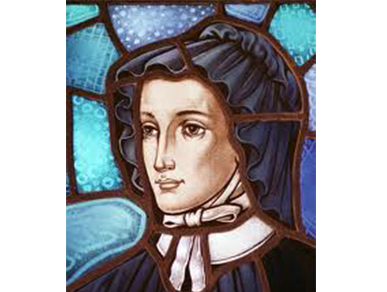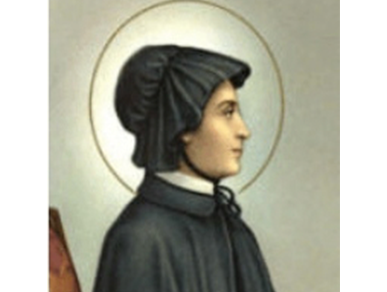Elizabeth Ann Seton

Elizabeth Ann Seton
Born two years before the American Revolution, Elizabeth grew up in the "cream" of New York society. She was a prolific reader, and read everything from the Bible to contemporary novels.
In spite of her high society background, Elizabeth's early life was quiet, simple, and often lonely. As she grew a little older, the Bible was to become her continual instruction, support and comfort; she would continue to love the Scriptures for the rest of her life.
In 1794, Elizabeth married the wealthy young William Seton, with whom she was deeply in love. The first years of their marriage were happy and prosperous. Elizabeth wrote in her diary at first autumn, "My own home at twenty - the world - that and heaven too - quite impossible."
This time of Elizabeth's life was to be a brief moment of earthly happiness before the many deaths and partings she was to suffer. Within four years, Will's father died, leaving the young couple in charge of Will's seven half brothers and sisters, as well as the family's importing business. Nowevents began to move fast - and with devastating effect. Both Will's business and his health failed. He was finally forced to file a petition of bankruptcy. In a final attempt to save Will's health, the Seton’s sailed for Italy, where Will had business friends. Will died of tuberculosis while in Italy. Elizabeth's one consolation was that Will had recently awakened to the things of God.
The many enforced separations from dear ones by death and distance, served to draw Elizabeth's heart to God and eternity. The accepting and embracing of God's will - "The Will," as she called it - would be a keynote in her spiritual life.
Elizabeth's deep concern for the spiritual welfare of her family and friends eventually led her into the Catholic Church. In Italy, Elizabeth captivated everyone by her own kindness, patience, good sense, wit and courtesy. During this time Elizabeth became interested in the Catholic Faith, and over a period of months, her Italian friends guided her in Catholic instructions.

Elizabeth Seton
Elizabeth's desire for the Bread of Life was to be a strong force leading her to the Catholic Church.
stsetonHaving lost her mother at an early age, Elizabeth felt great comfort in the idea that the Blessed Virgin was truly her mother. She asked the Blessed Virgin to guide her to the True Faith. Elizabeth finally joined the Catholic Church in 1805.
At the suggestion of the president of St. Mary's College in Baltimore, Maryland, Elizabeth started a school in that city. She and two other young women, who helped her in her work, began plans for a Sisterhood. They established the first free Catholic school in America. When the young community adopted their Rule, they made provisions for Elizabeth to continue raising her children.
On March 25, 1809, Elizabeth Seton pronounced her vows of poverty, chastity, and obedience, binding for one year. From that time she was called Mother Seton.
In June 1809 she moved her school and new community to Emmitsburg, Maryland. The order grew and she eventually also opened orphanages in Philadelphia and New York. Wherever she went she opened schools and started orphanages. Mother Seton wrote textbooks, translated books from French into English, and composed hymns and spiritual discourses, many of which have been published. She and her Order are tightly regarded as founders of the American parochial school system.
Although Mother Seton was now afflicted with tuberculosis, she continued to guide her children. The Rule of the Sisterhood was formally ratified in 1812. It was based upon the Rule St. Vincent de Paul had written for his Daughters of Charity in France. By 1818, in addition to their first school, the sisters had established two orphanages and another school. Today six groups of sisters trace their origins to Mother Seton's initial foundation.
For the last three years of her life, Elizabeth felt that God was getting ready to call her, and this gave her joy.
Mother Seton died in Emmitsburg on January 4,1821 at age 46, by which time her congregation, the first to be founded in America, had spread to some twenty houses across the United States. Their work and influence has grown ever since. There are now five independent communities of the Sisters of Charity. They staff hospitals like St. Mary's in Milwaukee andMequon, child-care institutions and homes for the aged and handicapped, and schools at every level. There are houses in South as well as North America, in Italy and mission countries.
She is buried under an altar in the chapel of the National Shrine of St. Elizabeth Seton in the provincial house of the Daughters of Charity in Emmitsburgh. The first miracle credited to her intercession, the cure of a nun with cancer, occurred in New Orleans Louisiana in 1935. She was Beatified and declared Blessed by Pope John XXIII in 1963. Pope Paul VI canonized St. Elizabeth Seton on September 14, 1975.
Many photographs on the website were taken by Ann Charles Photography
Please contact the webmaster
St. Elizabeth Seton Parish
